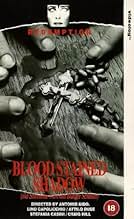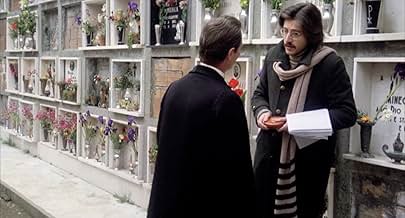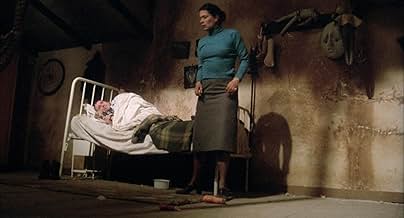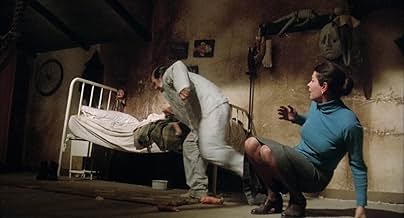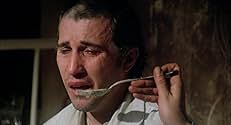IMDb RATING
6.3/10
2.2K
YOUR RATING
The body of a schoolgirl is found in a meadow. The murderer is never caught, and years later, a young man named Stefano returns to the island and is reunited with his brother, the local prie... Read allThe body of a schoolgirl is found in a meadow. The murderer is never caught, and years later, a young man named Stefano returns to the island and is reunited with his brother, the local priest.The body of a schoolgirl is found in a meadow. The murderer is never caught, and years later, a young man named Stefano returns to the island and is reunited with his brother, the local priest.
Craig Hill
- Don Paolo
- (as Graig Hill)
Alina De Simone
- Medium
- (as Alina Simoni)
Sonia Viviani
- Girl walking with Signora Nardi
- (as Sonia Vivani)
Fortunato Arena
- Antonio, Innkeeper
- (uncredited)
Antonio Bido
- Man at cemetary
- (uncredited)
Eolo Capritti
- Customer in restaurant
- (uncredited)
Featured reviews
Directed by Antonio Bido, this is by far his best film of his career (Though, admittedly, his only other film of any note is the 1977 Giallo "Watch Me When I Kill").
The film's narrative is relatively typical of a giallo: Someone is killing people in a small village and a priest tries to unravel the mystery of the killer's identity. What's atypical is the film's tone. The film is noteworthy for being one of the more serious and mature of the giallo genre. Bido avoids the giallo's often sleazy nature and embraces the Gothic and religious aspects instead.
Another interesting point is how the film focuses on two main protagonists, the priest and his brother, and how they collaborate with one another to discover the killer. Interesting narrative method having two focal points rather than one, not original but unconventional.
The performances are generally good with Craig Hill as giving an impressive performance as the priest. He exhibits a broad range of emotions from anger to sorrow, from determination to helplessness, and makes it totally convincing.
The cinematography is main feature of the film because it is its strongest trait. The visuals portray a wet and muggy Italy, with fog and mist enveloping the landscapes and rain falling, creating pools of water. This all builds a gloomy and foreboding atmosphere that conveys feelings of isolation, loneliness, dread, anguish, and death.
The characters are generally good as well, each with a strong history and believable relationships between one another. The greatest of which is the relationship between the priest and his brother, which is totally believable because not only of both of their performances, but also the development of their characters.
And lastly, the film features some wonderful aesthetic qualities through it's use of editing. Bido inter splices Catholic and Religious imagery to make comments about the characters and the religious institution as a whole.
The film has a few problematic issues. First of all, the narrative isn't clearly focused. The film appears to be more concerned with the visuals and the individual, isolated events in the film rather than the mystery as a whole. Thus, this damages the film's impact as it approaches the end, because here the mystery plays center stage but is underdeveloped.
The narrative also suffers from several of the genre's conventions and clichés, thus leading to a sort of predictability of the story. The film features the typical gloved killer, the extended stalking sequences leading to a gruesome death, the multiple red herrings, childhood traumas, and a host of other archetypes of the giallo.
Also, the final revelation stretches plausibility and thus may become unacceptable to some viewers, especially when one recalls the events that have transpired throughout the film.
Never the less, this is one of the better giallos out there.
Recommended to those who enjoy the mystery/thriller genre, though it is not essential unless you are a fan of the giallo genre. For the casual film viewer, there are better examples of the giallo genre and thus would recommend that you skip this and view one of the apexes of the genre such as Suspiria.
The film's narrative is relatively typical of a giallo: Someone is killing people in a small village and a priest tries to unravel the mystery of the killer's identity. What's atypical is the film's tone. The film is noteworthy for being one of the more serious and mature of the giallo genre. Bido avoids the giallo's often sleazy nature and embraces the Gothic and religious aspects instead.
Another interesting point is how the film focuses on two main protagonists, the priest and his brother, and how they collaborate with one another to discover the killer. Interesting narrative method having two focal points rather than one, not original but unconventional.
The performances are generally good with Craig Hill as giving an impressive performance as the priest. He exhibits a broad range of emotions from anger to sorrow, from determination to helplessness, and makes it totally convincing.
The cinematography is main feature of the film because it is its strongest trait. The visuals portray a wet and muggy Italy, with fog and mist enveloping the landscapes and rain falling, creating pools of water. This all builds a gloomy and foreboding atmosphere that conveys feelings of isolation, loneliness, dread, anguish, and death.
The characters are generally good as well, each with a strong history and believable relationships between one another. The greatest of which is the relationship between the priest and his brother, which is totally believable because not only of both of their performances, but also the development of their characters.
And lastly, the film features some wonderful aesthetic qualities through it's use of editing. Bido inter splices Catholic and Religious imagery to make comments about the characters and the religious institution as a whole.
The film has a few problematic issues. First of all, the narrative isn't clearly focused. The film appears to be more concerned with the visuals and the individual, isolated events in the film rather than the mystery as a whole. Thus, this damages the film's impact as it approaches the end, because here the mystery plays center stage but is underdeveloped.
The narrative also suffers from several of the genre's conventions and clichés, thus leading to a sort of predictability of the story. The film features the typical gloved killer, the extended stalking sequences leading to a gruesome death, the multiple red herrings, childhood traumas, and a host of other archetypes of the giallo.
Also, the final revelation stretches plausibility and thus may become unacceptable to some viewers, especially when one recalls the events that have transpired throughout the film.
Never the less, this is one of the better giallos out there.
Recommended to those who enjoy the mystery/thriller genre, though it is not essential unless you are a fan of the giallo genre. For the casual film viewer, there are better examples of the giallo genre and thus would recommend that you skip this and view one of the apexes of the genre such as Suspiria.
"The Bloodstained Shadow" is a film that requires patience. Had I not seen several giallos already, I might have fallen asleep in parts of this one. That being said, for giallo fans, this one is a worthy addition to your collection.
It starts out with a professor going back to his hometown, a small Italian island, and reuniting with his brother, a priest. The two become entangled in a web of murder and deception and it is somehow linked to the murder of a young girl year earlier. The setting is remarkable, the music is great and the acting is over par.
Then, we have the 'required' giallo elements. A love story. A suspect. Two suspects. Red herrings. Vague clues. Flashbacks. It gets a little ridiculous. By the time we find out who the killer is, (the first person I guessed,) we're a little worn out. There is a cheap shot which I cannot reveal because I'd give away the movie, but lets just say it's not fair to the viewer.
All being said, a really good ambiance and awesome setting give this film some merit. I'd recommend it to a hardcore giallo fan.
PS: now we know where the Blue Underground theme song comes from.
6 out of 10, kids.
It starts out with a professor going back to his hometown, a small Italian island, and reuniting with his brother, a priest. The two become entangled in a web of murder and deception and it is somehow linked to the murder of a young girl year earlier. The setting is remarkable, the music is great and the acting is over par.
Then, we have the 'required' giallo elements. A love story. A suspect. Two suspects. Red herrings. Vague clues. Flashbacks. It gets a little ridiculous. By the time we find out who the killer is, (the first person I guessed,) we're a little worn out. There is a cheap shot which I cannot reveal because I'd give away the movie, but lets just say it's not fair to the viewer.
All being said, a really good ambiance and awesome setting give this film some merit. I'd recommend it to a hardcore giallo fan.
PS: now we know where the Blue Underground theme song comes from.
6 out of 10, kids.
As fans of this particular genre, "giallo", knows there are some characteristics that have to be included: POV-shots from the killer, black gloves and grisly, graphic murders and so on! The gloves are missing here but everything else is! The story is set in Venice where bizarre events are unfolding, leading to death-threats and murders. And everything is connected to an episode many years ago, concerning the strangulation of a young girl. There are echoes from many other giallos, like the classic "Deep Red", but unlike so many other imitators, director Antonio Bido (who made the inferior giallo "The cat's victims") has a true feeling for setting up the set-pieces. His actors are also quite good even if the dubbing, as always, may distract from the viewers pleasure. His knows how to place his camera to enhance the suspense and atmosphere. To complain a little, I too found, like a previous reviewer here, that the episodes between Casini and Capolicchio are a bit squirm-inducing. They are simply put, very boring together, and even a nude scene fails to give any sparks. And the boat trip they take together is a scene that should have been omitted (I do HATE those sunglasses) because it seems to belong in another movie altogether, like some travelogue movie. But otherwise a nice exercise in suspense and horror, even if it is talky in places (most gialli are) and takes some time to get the pace going.
Sounds a bit strange that Antonio Bido just had few movies as director until now, this second entry on Giallo where he co-wrote and directed, however was his final movie in this specific genre, here he brings a holy figure of the Church, a Priest Don Paolo (Craig Hill) when arrives nearby Venice his young brother Stefano (Lino Capolicchio) a professor stressed by strange visions of the past over an unsolved murder of a girl, Lino has an occasional meeting at train's cabin with Sandra (The eye candy Stefania Casini), Lino was received warmly by Don Paolo, implying a true fraternal feelings, the Priest introduces to Lino his worries over weird facts in the little community, about a small group consisting by a Medium, a Doctor, a Middle age woman and a decaying drunkard Count, soon starts other crimes, even linked on those small group pointed out by Don Paolo, wisely the Director puts countless clues trying deceives the viewer, also Bido exposes on slight portions two sensitive matter which the Church faces nowadays, one woman complains to the Priest that his boy has been abused by the Count Pedrazzi (Massimo Serato) on his confession, indeed the rotten Count probable did such backbiting, due it was widely clear on his odd behavior with your butler, further he presents the Priest as all we know recognize as an unambiguous character, good movie!!
Resume:
First watch: 2020 / How many: 1 / Source: DVD / Rating: 7
Resume:
First watch: 2020 / How many: 1 / Source: DVD / Rating: 7
The Blood Stained Shadow is the second – and last - giallo that Antonio Bido directed. His other one was Watch Me When I Kill (a.k.a. The Cat's Victims). While Bido may never be considered one of the masters of the genre, I actually think his two efforts are rather good and at the very least he should be considered one of the best purveyors of the genre in the late 70's. There are some aspects that do stand out in Bido's gialli, making them distinctive. Firstly, there is a somewhat slightly more serious tone and secondly, and most significantly, both films dispense with young sexy women as murder victims. In fact, in both movies it's middle aged characters that end up as the killer's targets. It might not sound like much to some but it is highly unusual, and both of Bido's gialli follow the same pattern. So hats off to the director for being a little bit different. Other than an obligatory sex scene, The Blood Stained Shadow has really no sleaze factor at all.
The story begins with a mysterious slow-motion murder of a young girl. Several years later a maths teacher returns to his home town, where upon a series of murders ensues. Events seem to revolve around a séance group of local bad eggs.
This is another one of those occasional gialli that is set in Venice. The off-season spookiness of the canal streets was also used to good effect in films such as Don't Look Now and Who Saw Her Die? This city does give off a unique ambiance, which is once again utilised well. The film also includes several other odd details in its plot that will be familiar to fans of gialli, such as the weird painting, the retarded boy in the cellar and the present being governed by a terrible event from the past. All of this is put together to construct a film which, while possibly a bit overlong, has a mystery that does actually work in that it isn't too obvious where it's going and there are some decent red herrings sprinkled throughout.
Lino Capolicchio leads the picture. Many of you will be familiar with him from his turn in Pupi Avati's stand-out giallo The House with Laughing Windows. He's an interesting leading man. He's doesn't have the machismo of a Franco Nero, or the shiftiness of a Tomas Milian nor is he as suave as Jean Sorel. He plays characters a little more nerdy, which isn't so common in giallo leading men. He's good and is definitely a good choice for this more serious minded example of the genre. His leading lady is Stefania Cassini, most famous for her turn in Suspiria. I find her really very attractive and a good enough actress. Unfortunately, like here, she is normally dubbed into English by voice actresses. This is a mistake, as anyone who has seen the cult movie Blood for Dracula can confirm she has a beautiful, extremely heavy Italian accent that sounds simply divine. Ah well! The other significant contribution is the music. Stelvio Cipriani is the named composer but seemingly the legendary prog-rock outfit Goblin were key collaborators. It does sound a little Goblinesque at times - though not as good as their usual output to be fair. Still, it's a good soundtrack overall.
The Blood Stained Shadow is definitely recommended to giallo enthusiasts.
The story begins with a mysterious slow-motion murder of a young girl. Several years later a maths teacher returns to his home town, where upon a series of murders ensues. Events seem to revolve around a séance group of local bad eggs.
This is another one of those occasional gialli that is set in Venice. The off-season spookiness of the canal streets was also used to good effect in films such as Don't Look Now and Who Saw Her Die? This city does give off a unique ambiance, which is once again utilised well. The film also includes several other odd details in its plot that will be familiar to fans of gialli, such as the weird painting, the retarded boy in the cellar and the present being governed by a terrible event from the past. All of this is put together to construct a film which, while possibly a bit overlong, has a mystery that does actually work in that it isn't too obvious where it's going and there are some decent red herrings sprinkled throughout.
Lino Capolicchio leads the picture. Many of you will be familiar with him from his turn in Pupi Avati's stand-out giallo The House with Laughing Windows. He's an interesting leading man. He's doesn't have the machismo of a Franco Nero, or the shiftiness of a Tomas Milian nor is he as suave as Jean Sorel. He plays characters a little more nerdy, which isn't so common in giallo leading men. He's good and is definitely a good choice for this more serious minded example of the genre. His leading lady is Stefania Cassini, most famous for her turn in Suspiria. I find her really very attractive and a good enough actress. Unfortunately, like here, she is normally dubbed into English by voice actresses. This is a mistake, as anyone who has seen the cult movie Blood for Dracula can confirm she has a beautiful, extremely heavy Italian accent that sounds simply divine. Ah well! The other significant contribution is the music. Stelvio Cipriani is the named composer but seemingly the legendary prog-rock outfit Goblin were key collaborators. It does sound a little Goblinesque at times - though not as good as their usual output to be fair. Still, it's a good soundtrack overall.
The Blood Stained Shadow is definitely recommended to giallo enthusiasts.
Did you know
- TriviaAt 28'51' when Capolicchio introduces himself to Stefania Casini he tells her he is a Professor of Mathematics, Casini tells him that her job is to deal with furniture and Capolicchio calls her Architect, Stefania Casini actually graduated in Architecture at Polythechnic University of Milan.
- GoofsWhen the killer is being revealed and the main character pulls out the newspaper article, you can see and hear a flash from camera, probably taking pictures of the scene.
- ConnectionsFeatured in Solamente Bido (2002)
- How long is The Bloodstained Shadow?Powered by Alexa
Details
- Runtime1 hour 49 minutes
- Sound mix
- Aspect ratio
- 1.85 : 1
Contribute to this page
Suggest an edit or add missing content


